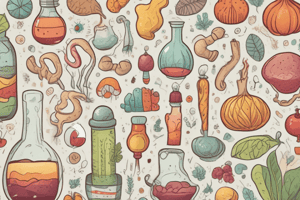Podcast
Questions and Answers
Carbohydrates are a type of biomolecule that contains a number of hydroxyl groups or their derivatives.
Carbohydrates are a type of biomolecule that contains a number of hydroxyl groups or their derivatives.
True (A)
Polysaccharides are classified as a type of monosaccharide.
Polysaccharides are classified as a type of monosaccharide.
False (B)
The general structure of monosaccharides is ramified.
The general structure of monosaccharides is ramified.
False (B)
The names of all sugars end in –ose.
The names of all sugars end in –ose.
Carbohydrates serve as energy stores and metabolic intermediates.
Carbohydrates serve as energy stores and metabolic intermediates.
Oligosaccharides contain 3-9 carbon atoms.
Oligosaccharides contain 3-9 carbon atoms.
The prefix D designates the absolute configuration of the asymmetric carbon closest to the aldehyde or ketone group.
The prefix D designates the absolute configuration of the asymmetric carbon closest to the aldehyde or ketone group.
Glyceraldehyde has two asymmetric carbons.
Glyceraldehyde has two asymmetric carbons.
Disaccharides are polymers consisting of chains of monosaccharide units.
Disaccharides are polymers consisting of chains of monosaccharide units.
The predominant forms of ribose, glucose, fructose, and many other sugars in solution are open chains.
The predominant forms of ribose, glucose, fructose, and many other sugars in solution are open chains.
Flashcards are hidden until you start studying
Study Notes
Carbohydrates
- Carbohydrates are a group of compounds containing hydroxyl groups or their derivatives, poorly soluble in organic solvents but soluble in water.
- They have several important functions for the organism, including serving as energy stores and metabolic intermediates.
Functions of Carbohydrates
- Ribose and deoxyribose sugars form part of the structural framework of RNA and DNA.
- Carbohydrates are important for tissue formation.
- They form the basis of human blood groups.
- Polysaccharides are structural elements in the cell walls of bacteria and plants.
- Carbohydrates link to many proteins and lipids, mediating interactions among cells and between cells and other elements.
Classification of Carbohydrates
- Monosaccharides: contain 3-9 carbon atoms, mostly 5 or 6, with an aldehyde or ketone group.
- Disaccharides: condensation products of two monosaccharide units, e.g., maltose and sucrose.
- Oligosaccharides: a few monosaccharides (3-10) covalently linked by glycosidic bonds.
- Polysaccharides: polymers consisting of chains of monosaccharide or disaccharide units, e.g., starches and dextrins.
Monosaccharides
- General structure is straight and not ramified.
- Every carbon atom carries a hydroxyl group except one.
- Contain an aldehyde or ketone group.
Nomenclature of Sugars
- Names end in –ose.
- Aldoses have an aldehyde group, while ketoses have a ketone group.
- Number of carbon atoms present in the molecule determines the prefix (e.g., triose, tetrose, pentose, hexose, heptose).
D and L Isomerism
- Isomers are molecules with the same kinds and numbers of atoms joined up in different ways.
- Prefixes D and L designate the absolute configuration of the asymmetric carbon farthest from the aldehyde or ketone group.
- D-isomer has the OH group on the right, while L-isomer has it on the left.
Cyclization of Monosaccharide
- The predominant forms of ribose, glucose, fructose, and many other sugars in solution are not open chains.
Studying That Suits You
Use AI to generate personalized quizzes and flashcards to suit your learning preferences.




